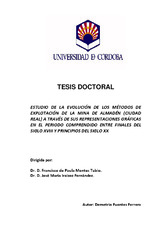Mostrar el registro sencillo del ítem
Estudio de la evolución de los métodos de explotación de la mina de Almadén (Ciudad Real) a través de sus representaciones gráficas en el periodo comprendido entre finales del siglo XVIII y principios del siglo XX
| dc.contributor.advisor | Montes Tubío, Francisco de Paula | |
| dc.contributor.advisor | Iraizoz Fernández, José María | |
| dc.contributor.author | Fuentes Ferrera, Demetrio | |
| dc.date.accessioned | 2012-07-18T10:29:05Z | |
| dc.date.available | 2012-07-18T10:29:05Z | |
| dc.date.issued | 2012 | |
| dc.identifier.uri | http://hdl.handle.net/10396/7638 | |
| dc.description.abstract | A principios del siglo XIX se establece un método de explotación único en la Mina de Almadén que perdura durante más de una centuria. Se debe su origen al Ingeniero Diego de Larrañaga, que por su particularidad,aparece descrito en todos los libros de laboreo de la época como un método de explotación exclusivo de las Minas de Almadén. Gracias a él, la mina fue capaz de producir los quintales de mercurio anuales exigidos por la Corona con cierta seguridad y continuidad de suministro, cosa que no había sucedido en épocas anteriores. El Método de Larrañaga apenas sufrió cambios a los largo del siglo XIX y principios del siglo XX, cuando es sustituido por el método de corte y relleno. Sin embargo, existieron propuestas de mejora y sustitución que nunca llegaron a implantarse. En ellas se ponía de manifiesto que problemas tenía el método original y como podían ser evitados o eliminados. Existen así varias comisiones e informes de estudio en este sentido. A través de este trabajo de investigación busca comprender como el sistema de explotación diseñado por Diego de Larrañaga pudo mantenerse durante 110 años a pesar de los informes oficiales de las comisiones de estudio y los avances tecnológicos que proponían su sustitución inmediata por el método de corte y relleno. | es_ES |
| dc.description.abstract | At the beginning of the XIXth century a new method of exploitation was established in the mine of Almadén that lasts during more than a a century. His origin is due the engineer Diego Larrañaga, that for its particularity, appears described in all the books of mining of the epoch like an exclusive method of exploitation of the mines of Almadén. Thanks to it, the mine was able to produce the yearly hundredweights of mercury demanded by the crown with certain certainty and supplying continuity, thing that had not happened on previous epochs. Thanks to him, the mine was able to produce the yearly hundredweights of mercury demanded by the crown with certain certainty and supplying continuity, thing that had not happened on previous epochs. Larrañaga's Method didn't have almost changes in all the XIXth century until principles of the XXth century, when it is replaced by the method of cut and stuffing. However, there were proposals of improving and substitution that never got to establish. In them it was manifested all the problems that the original method had and as they could be avoided or ruled-out. Several commissions and reports of study existed that they tried to work in that way. Through this research work, we seek to understand as the exploitation system designed by Diego Larrañaga could keep on during 110 years in spite of the official reports of the commissions of study and the technological advances that proposed its immediate substitution by the method of cut and fill. | es_ES |
| dc.format.mimetype | application/pdf | es_ES |
| dc.language.iso | spa | es_ES |
| dc.publisher | Universidad de Córdoba, Servicio de Publicaciones | es_ES |
| dc.rights | https://creativecommons.org/licenses/by-nc-nd/4.0/ | es_ES |
| dc.subject | Planos | es_ES |
| dc.subject | Laboreo de Minas | es_ES |
| dc.subject | Almadén (Ciudad Real, España) | es_ES |
| dc.subject | Tecnología | es_ES |
| dc.subject | Minas | es_ES |
| dc.subject | Maps | es_ES |
| dc.subject | Mining explotaition procedures | es_ES |
| dc.subject | Tecnologhy | es_ES |
| dc.subject | Mines | es_ES |
| dc.title | Estudio de la evolución de los métodos de explotación de la mina de Almadén (Ciudad Real) a través de sus representaciones gráficas en el periodo comprendido entre finales del siglo XVIII y principios del siglo XX | es_ES |
| dc.type | info:eu-repo/semantics/doctoralThesis | es_ES |
| dc.rights.accessRights | info:eu-repo/semantics/openAccess | es_ES |

